Meaning of Slanted Handwriting in Graphology
What is the meaning of slanted handwriting in graphology? Many times, those who seem to be very overwhelming and open actually hide shy and insecure personalities who speak about a little bit of everything, but they say nothing about themselves. Graphology, which is a projective technique, provides us with valuable information on multiple aspects of the personality of the human being through handwriting analysis. In the topic we deal with in this article, slant, we identify the degree of dependency and autonomy of people, the level of sociability and the need to establish bonds and share their experiences with others. Through slant, we detect vital attitudes, extroversion or introversion, which are announced by Carl Jung.
Which side do you slant your handwriting?
Writing behaves like the posture of our body before the presence of “the other”.
When we find someone we like, we lean our body forward in order to say hello. On the other hand, if the person is a stranger or we do not like this person, we keep our posture vertical. Handwriting works the same way, expressing our greater or lesser predisposition for human contact.
Social interest is a value that impulses humans to cultivate relationships with others, procuring to conceal interests in common. There is a great difference between having the need of contacting others and being able to achieve it. Sometimes, we seek to establish a bond. We have the natural ability to do it, but due to personal difficulties such as fears, bad experiences, self-esteem issues, we cannot achieve it. The greater the slant, the greater the importance we grant to “others” in each one´s life.
Handwriting slant is related to affection, initiative, with the ability for reflection and the tendency to apply intuition or logics.
From a business perspective, slant indicates: Persistence at work, concentration, order, organization, initiative and decision. This graphical aspect of handwriting allows us to discover social needs and contact needs of the individual, his attitude towards interpersonal relationships and the importance he grants to them.
Which part of the letters should we measure?
The meaning of slanted handwriting. A little clarification before we begin to speak about measures. A basic concept to understand graphology and to keep in mind: the areas of handwriting. Letters rest on a line or baseline. In each letter and each word, we find a superior area or upper extension, a middle area and an inferior area or lower extension. According to symbolism of space, Max Pulver affirms that in the act of writing, the individual describes himself: “conscious writing is a subconscious drawing.” Pulver is the creator of the symbolic school, applicable to all kinds of projective test. The superior area reflects intellectual and spiritual thinking. The middle area reflects emotions, social ethics and daily routines. The inferior area represents physical and instinctive needs. Whatever slants rightwards indicates extroversion and tendencies for contact with others. Whatever slants leftwards is attachment to the mother´s womb, the family and indicates regression.
In order to measure the inclination of letters we must first draw the baseline or line where all or the majority of letters rest. From there, we measure upper extensions or superior parts of letters “I”, “ll”, “b”, “h”, “d”, “f”, how much they deviate from the perpendicular edge. With the goal of observing slant, we extend letters upwards and we measure the angle they form with the baseline. Then, using a protractor, we take the measures. Capital letters are good for measuring, where there are letters that are very difficult to measure (like a, o, e, c, v, r). The quantity of letters to be measured will depend on the size of the sample and the exactitude we desire to obtain.

In Graphology “slanted” always means inclined to the right and when we speak about “inverted” or sinistrogyrous we interpret inclined to the left. (In spanish we say inclined: Right side, and inverted: Left side).
It is important to clarify, like in all graphical aspects, that inclination by itself does not have any value for interpretation, but that it needs to be confirmed with other signs. Although each sign is granted a value or meaning, the sense is acquired in context.
Module for slant: It indicates that handwriting must be slightly slanted (moderated dextrogyrous) or vertical: The more slant the more dependency on others.
What is the reference point for each graphical aspect?
The module is the measure or reference point that we shall consider normal. It is possible that the analyzed aspect in a given text is found within what the module requires as NORMAL, BIGGER or SMALLER than the module. In the cases there is a difference from what has been established, the corresponding psychological interpretation shall be given.
The meaning of slanted handwriting: According to slant, we classify the different types of slant:
Very Slanted (defined dextrogyrous or lied down)

When upper and lower extensions form an angle between 30º and 45º, this indicates lack of objectivity, loss of self-control, great affection and defined extroversion. Exaggerated dramatization in feelings that may be positive, but may turn into bad or resentment upon minimum disappointment.
On the negative side: Exaggerated value for situations or people, loss of control, impulsiveness, passion, desire to call attention, (if the inferior area prevails: need for love), thoughtlessness, aggression, lack of touch.
With regressive signs on final strokes and capital letters: Jealousy, affective selfishness, need for hoarding affection and attention of those who surround him.
Moderate Slant (moderate dextrogyrous)
Upper extensions are slanted, forming an angle from 55º to 60º approximately. This type of writing reveals harmony in tendencies between feelings and logics. Good level of intelligence, extroversion, ability for reflection and synthesis. Affective people, need for the presence of others, affective stability, feelings and reason go together. Independence of criteria that accepts social norms.
Right Slanted Handwriting
On the positive side: Expansion, need for giving and receiving affection, sympathy, kindness, comprehension, solidarity, adjusts and integrates easily, honesty (with curved graphisms). On the negative side: conventionalism, adjusts by custom or routine, flattening kindness. With angled graphisms: tendency to opposition, resistance and thoughtlessness.
Vertical or Straight Slant
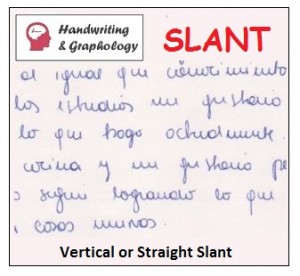
Upper and lower extensions form a straight angle (of 90º) with the horizontal line (a variation of 5º towards the right or left is accepted). The individual who writes this way enjoys self-control. Firm criteria, stable attitude, calm, determination in thinking and character. Maturity in conduct, control for desire and feelings, clarity and persistence in thinking. Ability for observation, reflection, reserve. Little need for presence of others, which does not mean there is no sensitivity or affection. Controlled passions in love life. On the negative side: Indifference, coldness, distrust, impassivity. May be proud individuals, cold or indifferent, since they choose to think before feeling. Hard for coexisting. If accompanied by curves: Good level of intelligence, reason and thinking prevail over emotions. If angles prevail: Indifference coldness. If also over elevated and rigid: Obstinacy, inflexibility, hard feelings.
What Does Left-Slanted Handwriting Say?
Sinistrogyrous or Regressive
This is how we call writing which letters are slanted towards the varying between 92º and 150º. In this case (letter which is slanted towards the left) there is no progression, no moving forward. This means that there is a defensive attitude, of rejection and repression. Introversion, disassociated conduct that does not manage to express what the individual feels. Represses impulses and need for affection and contact. Who has lacked affection during childhood, in adulthood will feel conditioned to avoid friction, conflicts, that might be associated to old inner frustrations. Inverted writing expresses repression, for whatever reason, the person fears, distrusts and is not able to free his tendencies. Feels distrusts of the intentions of the ones that surround him, inferiority feelings, narcissism, egocentrism. May also be slowness in ideas , but with great ability for concentration. These are very discrete individuals, cautious, reserved and prudent. Introverted and insecure. They demand protection. They establish dependent relationships since they were not able to detach from the mother. They present difficulties for social adaptation. This writing is hard to interpret. That is why it is necessary to confirm with other signs.

Moderate inverted writing
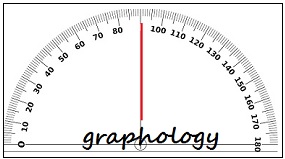
The inversion of writing is interpreted as the search for shelter in the inner world as a defense mechanism towards a situation in which the individual needs to avoid himself. Perceives the pressure of the environment as anguish. Tendency to withdrawal. Decision-making is complicated and initiative is limited. Little self-confidence, social relationships and bonds are difficult, distrust, disguise, lack of honesty.
Very sinistrogyrous or fallen towards the left
This writing denotes personal problems that lead to protection towards the outside world. Strong introversion, inhibition, escape, frustration, reserve, disguise, lack of adaptation, isolation, depression. On the negative side: egocentrism, distrust, falseness, lies, hypocrisy. May suffer an affective block, although might have subconsciously great affective needs that cannot express.
What does it mean, if your handwriting turns to the left?
Tends to repress aggression and projects this energy on himself, provoking tendencies to depression. We need to make sure that the writing implementation, the position of the sheet of paper, posture and the hand being used are correct. When for many reasons the left hand is used, we may find fallen writing.
Handwriting slants both ways: Unequal Slant
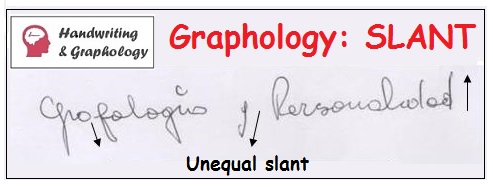
Graphology: Varying Slant
When is writing considered unequal?
We call unequal or varying writing the one which letters have a slant between vertical, inclined and inverted. On the positive side, there is ability for adjustment to others´ needs without thinking in own desires or needs. It is possible that we are before a changing personality, but with ability to adjust to the other´s state of mind. It could happen that the individual faces a duel between what he wants and what does not want, ambivalence, between desire and fear, which generates a great deal of anguish. Doubts, hesitation, uncertainties. On the negative side: this is translated as contradictions, difficulties in adjustment, capricious person. This speaks about affectively unstable individuals with difficulties to adjust to norms.
This concludes the article about of the Meaning of slanted handwriting. Feel free to share it with your contacts if you found it useful.

Keep reading this blog to learn more about Graphology letter “a” lowercase and Handwriting Interpretation: Print and Cursive. Follow us on Facebook!

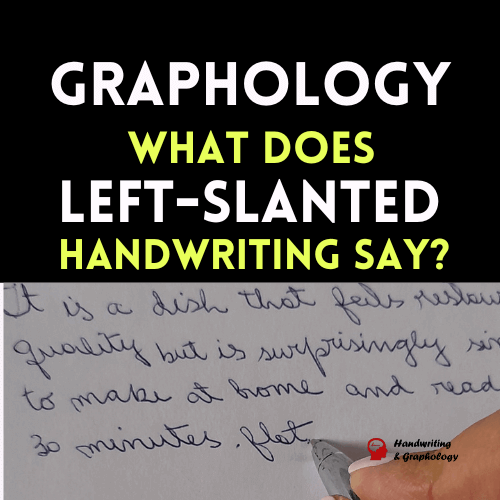
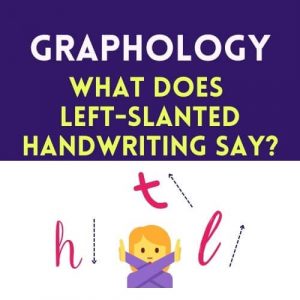
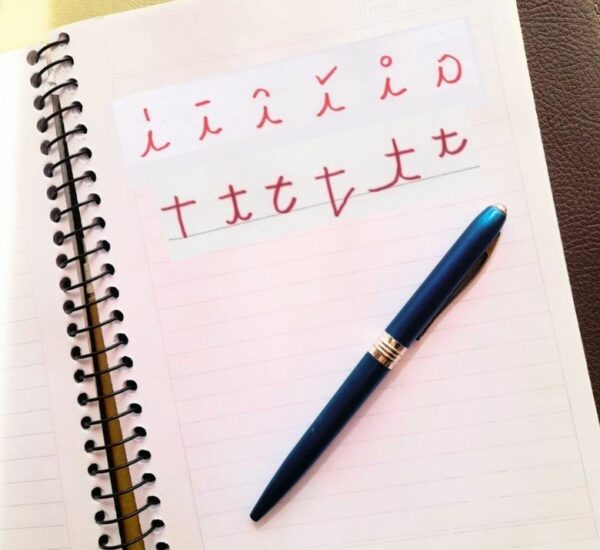
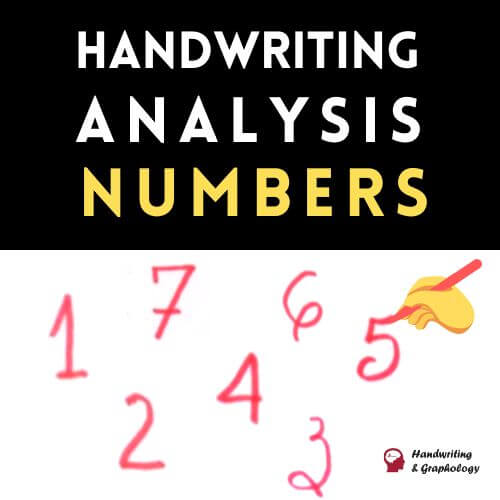
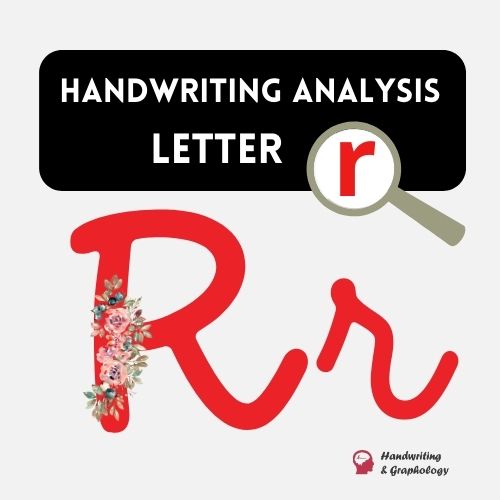
What if you write at a certain slant because you were taught a certain type of cursive?
even if you were taught that way, you will end up being more inclined towards one side or the other naturally. It’s not a conscious thing, for example I have an unequal slant, but I was taught to write with a forward slant.
I loved reading about handwriting.
First i had slight right slant, but as i grew up, it started becoming straight, with out slant… now I’m 17 and i write totally straight!
I was very interested into this article, as I my self am left-slant writing. I do feel a bit relieved, about this situation; as most people asking questions about my writing style. Lucky/or unlucky, we now communicate via standard computer-writing.
I’ve gone trough a whole live, even no-one would like it. As European, I live in Vietnam, and I experienced that on communication my left handwriting, has gone extreme. Sometimes I feel like an alien in an other world. So, I try to minimize my communication, which I feel bad about it. I’m dam good at my job. I do have a high level of self-joking on my self (a way to protect myself). I learned, that if you are ready to lose face (very important in Asia) One actually gain face. I don’t care if people slab me in the face., as the world stills goes around after. Thanks for publishing this article.
I started to back slant when I was always picked out at school as an example of good writing.
It was a protest and it stuck with me.